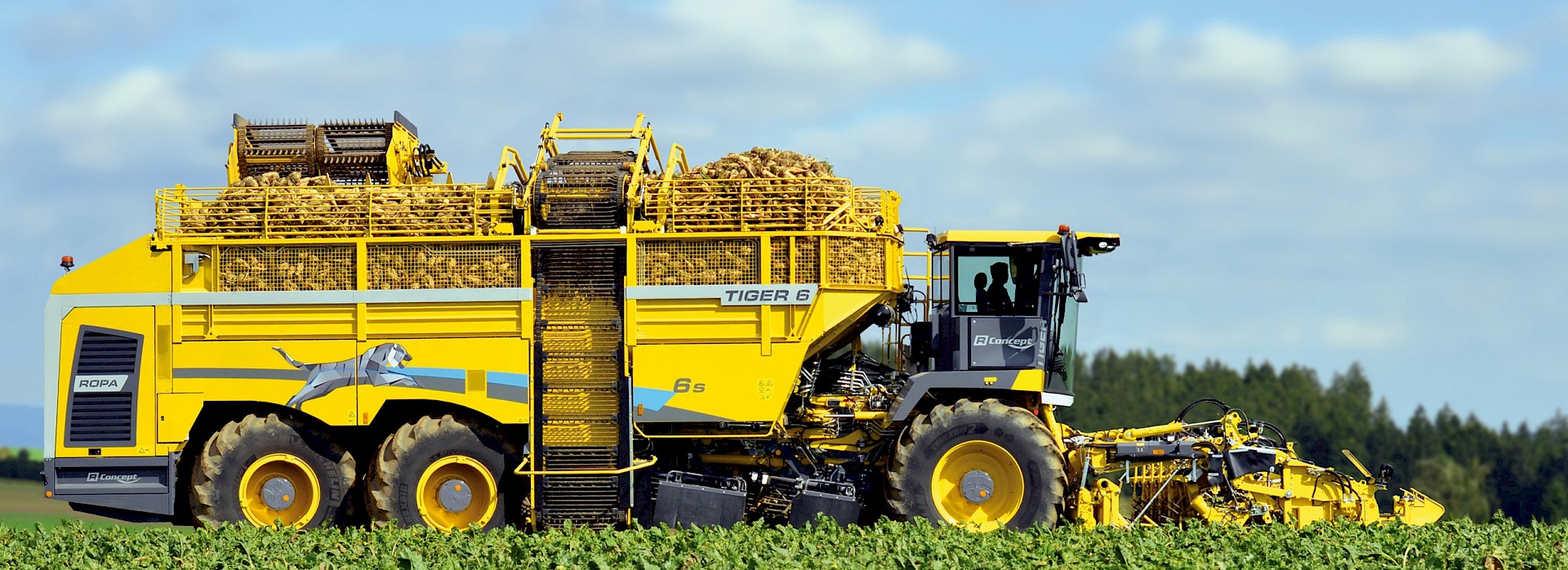Tiger 6S
ROPA Tiger 6S - still more efficiency paired with digital networking in the world's highest-performance sugar beet harvester from the world market leader
ROPA is expanding its self-driving sugar beet harvester segment to include the Tiger 6S model, which will be available in series production for the 2020 harvest. After several years of field tests, the model will be available as a pre-series for the 2019 season in parts of Europe. A new generation of extremely high-performance on-board computers is the basis for telematics, predictive analytics, online diagnostics, and partially autonomous sugar beet harvesting. The Tiger 6S dominates the premium segment of the market and with its visionary computer architecture is much more than the technical and visual enhancement of the current Tiger 6.
Printout of the innovative enhancements in the exterior design of the Tiger 6S
Even the new look of the ROPA Tiger 6S symbolizes digitalization and agriculture 4.0. The light blue line clarifies and stands for the networking of the Tiger with itself and with the R-Connect online portal. The emphasis of the new product logo relies on the smooth geometric forms in the low-poly style. Thanks to the play of light and shadow, the tiger 6S has additional depth and dynamics. The prominent coloration with dark gray exterior contours is in harmony with light aluminum gray and bright yellow. The Tiger is designed for pride in ownership, to arouse emotion and at the same time to meet the promise of quality.
Two engine options - power packages with mega torque - extremely cost-effective
Volvo Penta TWD1683VE with 796 PS / 585 kW
This engine was designed by Volvo Penta especially for use in the Tiger 6S. With a capacity of 16.12 liters, common rail injection, SCR catalytic converter, and AdBlue, this type of engine provides power more efficiently and "cleanly."
With doubled turbocharging, this power package generates enormous maximum torque of 3650 Nm. Starting at 1000 rpm, it provides 3550 Nm, which means that you can harvest longer in the lower speed range and therefore save more fuel. Thanks to the modern engine technology, this diesel engine also complies with the European exhaust stage V without exhaust gas recirculation.
The basis for greater daily output with less fuel consumption and even more power at lower speeds.
Volvo Penta TAD1643VE-B with 768 PS / 565 kW
With a capacity of 16.12 liters and pump-nozzle injection (PDE), the engine of Tiger 6Sa is the reliable and robust power package, that many customers already know and appreciate from Tiger 6a. This engine does not require AdBlue, SCR catalyst and exhaust gas recirculation. A torque of 3260 Nm is transmitted by the stepless traction drive at optimal efficiency. This engine will no longer be available in the EU from the year 2021 due to changes in legislation.
Panorama cabin with improved, comfortable operation and two R-Touch displays
In comparison with its predecessors, the Tiger 6S has two 12.1-inch operating terminals with high pixel density resulting in even sharper resolution. Operation at the terminal with interactive buttons is even more intuitive and uses the same logic as tablets and smartphones.
In addition to the machine functions, two separate video streams can also be shown on the R-Touch display on the left A-pillar.
R-Connect Online Portal
R-Connect telematics module and remote diagnostics as standard equipment
The ROPA Tiger 6S comes with the efficient telematics hardware including SIM card for online access as standard equipment. The telematics module is thus the basis for proactive Service 4.0 with predictive analytics and fast assistance and diagnostics if service is required on any continent. When service is required, if desired the service technician can switch directly to the terminal and the machine control and assist the driver, e.g. with problem-solving.
R-Trim - automatic defoliator height adjustment
At Agritechnica in Hannover, ROPA presented two new developments that automatically adjust the working depths of the harvesting attachment on the Tiger 6S:
• R-Trim - automatic adjustment of the defoliator height
• R-Contour - automatic share depth adjustment of the individual rows at the RR lifting unit
Both systems adapt their working depth to the changing conditions in the beet crop throughout the field. The automatic systems react to different crown heights or to ground unevenness crosswise to the direction of travel. The currently used measuring system at the scalper has been extended to include an additional measuring system for recording the ground contour directly at the beet rows.
R-Contour
Automatic share depth adjustment of the individual rows at the RR lifting unit
The driver uses the joystick on the operating console to set the lifting depth as required and thus defines how deep the lifter share will penetrate the soil. Ultrasonic sensors beside every beet row record the ground surface contour. A new, powerful on-board computer processes the measured values and ensures that the lifting depth is maintained in accordance with the ground contour. Compared to the previous systems for automatic adjustment of single rows, this system has many advantages, particularly with higher growth in beet rows beside roads.
R-Balance - hydraulic chassis with slope compensation
Up to 10% slope compensation
The automatic slope compensation via six hydraulic cylinders and sensors is also unique among 3-axle sugar beet harvesters. The chassis is kept completely horizontally for up to 10 percent side slope. The gravity center and, thus, the load of the wheels on the slope bottom are shifted to the slope top.
Focal point / soil pressure compensation
The track depth of the wheels on the slope bottom is substantially reduced, the infiltration capacity is retained, thus significantly reducing erosion risk during heavy rains.
The slope stability and traction increase greatly, the risk of tipping over is considerably reduced alongside with increased driving comfort.

























